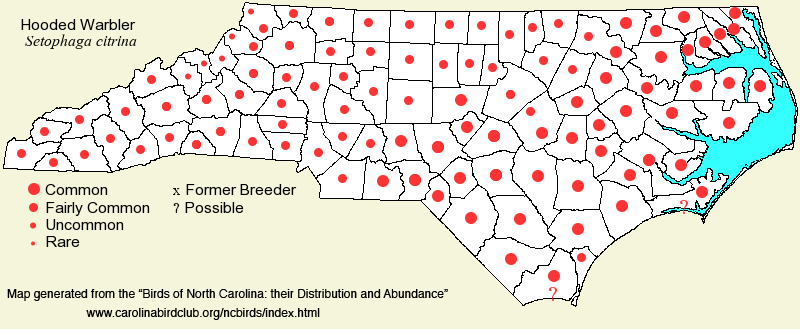 |  |
|
Hooded Warbler - Setophaga citrina PARULIDAE Members: | Search Common: Search Scientific: |
|
|
|||||||
| General Comments | The Hooded Warbler, as have so many other warblers, been shifted from one genus to another in 2011, and is included with all of the others in the former large Dendroica genus into Setophaga, with the American Redstart! The Hooded is a classic Eastern deciduous forest species, with a breeding range over essentially all of the Eastern states and nesting in all North Carolina counties. Like most warblers, it winters entirely south of the United States. It is a forest understory species, inhabiting the 10-30-foot high zone well below the canopy of the forest. It favors moderate to fairy thick stands of shrubs and understory trees, usually in a moist hardwood forest, but they also nest in mixed forests or even pine stands with a regenerating hardwood layer. It also nests in older clearcut stands as well. They are most numerous in brownwater river floodplains and are not common near or along blackwater rivers. In the mountains, they are often found in rhododendron or mountain laurel stands, preferably where somewhat moist. Numbers in the state have declined somewhat, owing to habitat loss, at least in counties with a high human population. | ||||||
| Breeding Status | Breeder | ||||||
| NC BRC List | Definitive | ||||||
| State Status | |||||||
| U.S. Status | |||||||
| State Rank | S5B | ||||||
| Global Rank | G5 | ||||||
| Coastal Plain | Summer resident. Generally common throughout the region, except on coastal islands, where absent in most areas. However, not as numerous in some nonriverine swamp areas and blackwater river systems in the far eastern counties as it is farther inland. Mainly early or mid-Apr to early Oct. Latest date is "only" 12 Nov, though there is a report of 28 Dec (no year given) from Wilmington (Pearson et al., 1959). Peak counts: | ||||||
| Piedmont | Summer resident. Fairly common to common in most areas, away from heavily populated counties; probably less numerous in the central counties, but common in heavily forested portions of the eastern and foothill counties. Mainly early or mid-Apr to late Sep; once into early Nov. Peak counts: | ||||||
| Mountains | Summer resident. Fairly common to common over the region, up to about 4,000 feet, and much less common to 4,500 feet. Mainly mid-Apr to early Oct. One seen and recorded singing near Brevard (Transylvania) on 14 Mar 2019 was exceptionally early. Peak counts: | ||||||
| Finding Tips |
It should easily be heard, if not seen, in most state parks and refuges in a morning of birding, in spring or early summer. **** | ||||||
| Attribution | LeGrand[2023-04-07], LeGrand[2019-08-14], LeGrand[2013-12-13] | ||||||
| NC Map Map depicts all counties with a report (transient or resident) for the species. | Click on county for list of all known species. |
| NC Breeding Season Map Map depicts assumed breeding season abundance for the species. |  |